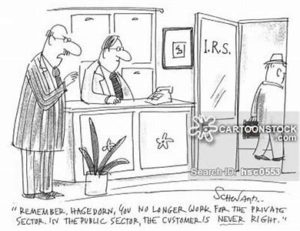Here’s what’s up! The IRS is patting its own back on how great they did customer service-wise during the 2017 tax season. The reviews are mixed but today’s blog is to introduce the IRS’ customer service platforms, should you need customer service.
REINFORCING THE BASICS.
What is customer service? It is taking care of taxpayers’ needs by providing professional and helpful high-quality assistance before during and after the taxpayer’s requirements  are met. Those requirements being taxpayers self-report their income annually and submit income tax payments.
are met. Those requirements being taxpayers self-report their income annually and submit income tax payments.
What is an assistor? An IRS customer service rep.
CUSTOMER SERVICE.
Here’s a fun fact; in the last five years the IRS has downsized 10,876 fulltime employees, which was a 12.7% percent reduction in the fulltime workforce. Now, true, that could be fewer auditors, but it could also be fewer computer technicians and assistors to taxpayer inquiries. And that is not good for America’s taxpayers. Last year the IRS processed 245.4 million tax returns; each return is a customer.
IRS Notices/Correspondence. You can write an old-fashioned letter (paper correspondence) and snail mail it to the IRS. Most of these letters are in response to IRS requests for information, giving the IRS even more information, or disagreeing with them about something (taxpayer dispute). IRS assistors answer these letters which also include procedural questions, amended returns, and duplicate filings. The goal is to answer each letter within 45 days. Day 46, if unanswered, your correspondence becomes “overage”. The IRS received 17.5 million pieces of correspondence last year.
The National Taxpayer Advocate, (in short IRS watchdog for taxpayers), reports that in 2017 the IRS had 35% overage. That is 6,125,000 pieces of unanswered mail. Holy heck,  where do they put it all?
where do they put it all?
The IRS, was like, uh no and called this finding BS because at year-end they claim 35% of open inventory was only 1.3 million pieces, not 6.1 million pieces and of which only 514,000 pieces were our unanswered taxpayer-initiated correspondence. With this math the IRS had 786,00 unfinished internally generated documents associated with account maintenance operations. And blahblahblah.
Online Services. The IRS Website
You can do a number of things online. View your account, get your tax record/transcript, make a payment, check your refund status, check on an amended return, and get tax forms and instructions.
Last year there were 495.6 million visits to IRS.gov and 278.6 million inquiries to “Where’s My Refund?”
There is a ton of information on the website and we do mean a ton. The “Frequently Asked Questions and Answers Search” and “The Interactive Tax Assistant Search” are great tools to find answers to questions and navigate through topics and categories:
Tax Cuts and Jobs Act (TCJA) or Public Law 11597. Of course, the IRS has been worried this past year about messing up because of the broad scope and complexity of the law and all there is to mess up which includes extensive changes to tax forms, publications, and computer systems. All in all, there are about 120 provisions requiring the creation or revision of nearly 450 forms, publications, and sets of instructions. And approximately 140 IT systems need modifications in order to process returns and monitor compliance.
In a strategy not to mess up, the IRS set up a centralized office to coordinate implementation across the agency’s offices and divisions and even developed their very own project planning tool. The IRS also hit up Congress for an additional $397M to fund the TCJA’s implementation costs and they got 320.
We hope they did a good job with less money because it is anticipated that there will be four million TCJA-related, taxpayer-initiated letters, phone calls, and in-person visits to tax centers.
Telephone Service. Phone operators will assist callers year-round with obtaining account information and answering basic tax law questions. The telephone service also has recorded tax information and a bunch of automated services. You can call them up and find out the status of your refund, how much you owe, and a bunch of other stuff.
If you ever wondered why the IRS isn’t answering your call; you are not the only one. Between 2013 and 2017, the IRS averaged 107 million telephone calls from taxpayers each year. According to them, a couple of years ago they only answered 37.5% of calls and the average wait time was 23 minutes. Supposedly, as of last year they answered 80% of live assistance seeking calls and reduced wait times to about 5 minutes. Independent audits show those numbers to be much lower.
Currently, their website says 15-minute wait time during tax season and 27-minutes the rest of the year. We all know that’s fake news because we all know someone who has complained they were on hold for 45 minutes or an hour or even longer. To amuse yourself while on hold we recommend streaming Amazon’s original series Sneaky Pete or even old episodes of American Horror Story because well, isn’t that what dealing with the IRS is.
This is super important to know: The IRS will NEVER, NEVER, NEVER call you up on the phone out of the blue. And they will NEVER, NEVER, NEVER text you. NEVER, EVER!
If you are calling about your own account make sure you have all this stuff ready: Social security number or Individual Taxpayer Identification Number; birthdate, filing status, last year’s tax return, the return you are calling about, and any notices the IRS sent you. It would suck to have to call back.
 Business 800-829-4933
Business 800-829-4933
Disaster or Combat Zone Special Hotline 866-562-5227
Individual 800-829-1040 (Cute!)
Refund Hotline 800-825-1954
TTY/TTD 800-829-4059
Visits to Taxpayer Assistance Centers (The Last Resort). Fortunately, nearly every tax challenge we have can be resolved either by correspondence, online or by telephone. If all else fails and you have to go in person, use this cool IRS tool to find out where to go, office hours, and to schedule an appointment. For an added bonus, the local telephone number is provided too.
Taxpayer Assistance Center Office Locator
WHAT ELSE SHOULD I KNOW?
⇒ The IRS is required to pay interest on amended return refunds if not processed within 45 days.
⇒ Telephone service wait times tend to be higher on Monday and Tuesday, during President’s Day weekend, and of course, right around the April filing deadline.
⇒ Our client service is so much better than the IRS’ customer service.
So #CallCarolFirst!
info@accpas.com OR 727-327-1999.
Check back here next week for a new and entertaining blog. And be sure to like us on FaceBook and follow us on Twitter; for whatever it is we’ll be posting.
ANY TAX ADVICE IN THIS COMMUNICATION IS NOT INTENDED OR WRITTEN TO BE USED, AND CANNOT BE USED, BY A CLIENT OR ANY OTHER PERSON OR ENTITY FOR THE PURPOSE OF (i) AVOIDING PENALTIES THAT MAY BE IMPOSED ON ANY TAXPAYER OR (ii) PROMOTING, MARKETING OR RECOMMENDING TO ANOTHER PARTY ANY MATTERS ADDRESSED HEREIN.
